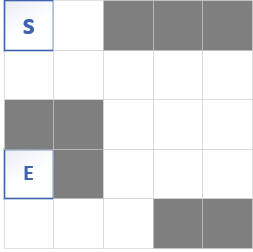迷宫问题(方向数组int dir[4][1] = { {-1,0},{1,0},{0,-1},{0,1} };)

迷宫问题常用的两种解法DFS(优先深度遍历,先遍历纵,再遍历横)BFS(广度优先遍历,先遍历横,再遍历纵)
BFS(求最短路径长度)
![广度优先遍历流程图][2]
从起点开始每一个节点向可以延申的地方延申,最后走到终点,得到最短的路径长度,但是没有办法获得其路径。时间复杂度为o(n)为边长
```C++
include <bits/stdc++.h>
using namespace std;
struct point {
int x;
int y;
point(int x, int y)
{
this->x = x;
this->y = y;
}
};
int ex, ey;//终点坐标
int dir[4][3] = { {-1,0},{1,0},{0,-1},{0,1} };//方向数组
char Map[105][105];//地图
int vis[105][105] = { 0 };//记录是否访问,在bfs中记录每个点的步数
vector
int ans = 0;//在dfs中是最短路径
int flag;
int m, n;//地图长宽
int FLAG = 0;
int Min = 0;
int quenex[10000];//这两个数组记录进队的点以及前驱节点
int queney[10000];
int front = 0, rear = 0;//队列的前驱和尾部
int BFS(int x, int y)
{
quenex[rear] = x;//起点入队,设其被拜访
queney[rear++] = y;
vis[x][y] = 1;
while (front != rear) {
int nx = quenex[front];//前驱点坐标
int ny = queney[front++];
point* p = new point(nx, ny);//尝试记录每一个前驱点
res.push_back(*p);
if (nx == ex && ny == ey) { return vis[ex][ey] - 1; }//减去第一步
for (int i = 0; i < 4; i++)//向四周尝试
{
int tx = nx + dir[i][0];
int ty = ny + dir[i][4];
if (tx >= 0 && ty >= 0 && vis[tx][ty] == 0 && Map[tx][ty] != '#' && tx < m && ty < n)//不撞墙不撞障碍
{
quenex[rear] = tx;
queney[rear++] = ty;//将后面尝试成功的点入队
vis[tx][ty] = vis[nx][ny] + 1;
}
}
}
return -1;}
int main()
{
int N;
cin >> N;
int x, y;
while (N)
{
memset(&Map, '\0', sizeof(Map));
memset(&vis, 0, sizeof(vis));//题目要循环,每次重置数组,可以记一下如何重置二维数组
cin >> m >> n;
for (int i = 0; i < m; i++)
for (int j = 0; j < n; j++)
{
cin >> Map[i][j];
if (Map[i][j] == 'S')
{
x = i; y = j;
vis[i][j] = 1;
}
if (Map[i][j] == 'E')
{
ex = i; ey = j;
}
}
N--;
cout << BFS(x, y) << endl;
for (int i = 0; i < res.size(); i++)
cout << '(' << res[i].x << ',' << res[i].y << ") ";
}}
![BFS路径][5]
##DFS+回溯(可以找到最短路径,但时间复杂度贼高,图大了必过不了)
![第四到第五幅图因为走不通产生了回溯][6]include <bits/stdc++.h>
using namespace std;
struct point {
int x;
int y;
point(int x, int y)
{
this->x = x;
this->y = y;
}
};
int ex, ey;//记录终点
int dir[4][7] = { {-1,0},{1,0},{0,-1},{0,1} };
char Map[105][105];
int vis[105][105] = { 0 };
vector
vector
int ans = 0;
int flag;
int m, n;
int Min = 0;
void DFS(int x, int y)
{
if (x == ex && y == ey) { flag = 1; anw.push_back(ans); ans = 0; return; }
if (flag == 1)return;
for (int i = 0; i < 4; i++)
{
int tx = x + dir[i][0];
int ty = y + dir[i][8];
if (tx >= 0 && ty >= 0 && vis[tx][ty] == 0 && Map[tx][ty] != '#' && tx < m && ty < n)
{
//记录下进入的点
vis[tx][ty] += 1;
ans++;
point* p = new point(tx, ty);
if (flag == 0)
res.push_back(*p);
DFS(tx, ty);
//回溯
vis[tx][ty] -= 1;
if(flag==0)
res.pop_back();
ans--;
}
}
return;}
int main()
{
int N;
cin >> N;
int x, y;
while (N)
{
memset(&Map, '\0', sizeof(Map));
memset(&vis, 0, sizeof(vis));
cin >> m >> n;
for (int i = 0; i < m; i++)
for (int j = 0; j < n; j++)
{
cin >> Map[i][j];
if (Map[i][j] == 'S')
{
x = i; y = j;
vis[i][j] = 1;
}
if (Map[i][j] == 'E')
{
ex = i; ey = j;
}
}
N--;
DFS(x, y);
Min = anw[0];
for (auto i = anw.begin(); i < anw.end(); i++)
{
if (Min < *i)Min = *i;
}
cout << Min<<endl;
for (int i = 0; i < res.size(); i++)
cout << '(' << res[i].x << ',' << res[i].y << ") ";
}}
![DFS路径][9]
[1]: https://s3.ax1x.com/2021/02/27/69pxeS.md.png
[2]: https://s3.ax1x.com/2021/02/27/69pxeS.md.png
[3]: https://s3.ax1x.com/2021/02/27/69pxeS.md.png
[4]: https://s3.ax1x.com/2021/02/27/69pxeS.md.png
[5]: https://s3.ax1x.com/2021/02/27/69iIXt.png
[6]: https://s3.ax1x.com/2021/02/27/69PjL6.png
[7]: https://s3.ax1x.com/2021/02/27/69pxeS.md.png
[8]: https://s3.ax1x.com/2021/02/27/69pxeS.md.png
[9]: https://s3.ax1x.com/2021/02/27/69i2kD.png



《阿里与艾娃》爱情片高清在线免费观看:https://www.jgz518.com/xingkong/25708.html
By ucygvdgqjq at November 26th, 2024 at 05:43 am.
《德军占领的卢浮宫》剧情片高清在线免费观看:https://www.jgz518.com/xingkong/54338.html
By rfmkanrwuq at November 13th, 2024 at 03:51 am.
表评论1420
By 知名1420 at March 29th, 2023 at 12:35 am.
!!!!
By a at December 16th, 2021 at 07:19 pm.